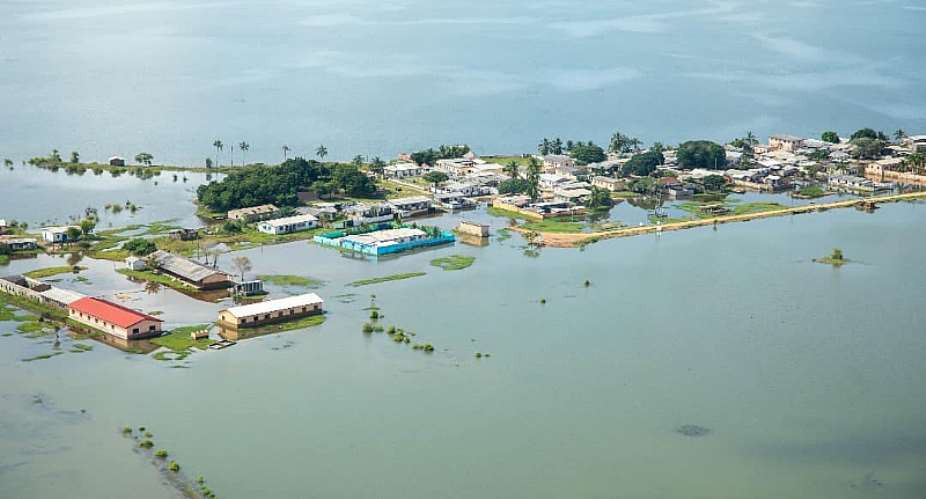About 26,000 people have so far had their homes and livelihoods swept away by floodwater, gusting out of the spillways of the Akosombo and the Kpong dams in the Eastern region.
The Volta River Authority (VRA) started the “controlled spillage” at both dams from September 15, 2023, following rising water levels in both reservoirs.
As of 17th October 2023, many persons had been displaced as a result of the spillage. This is the highest magnitude of displacement and volume since the building of the Akosombo Dam, a reservoir on the Volta River, which six tributaries take their sources in the Sahel.
This is not the first time VRA is spilling water from the Akosombo Dam. Spilling was done in 1966, 1967, 1968, 1969, 1970, 1971, 1972, 1974, 1991 and more recently 2010.
The main causes
Data from the Ghana Meteorology Agency (GMet) shows that the Sahelian countries are receiving above normal rainfall.
“This means if the area normally receives two liters of rain, it is now getting, two and half, three liters or more flowing through to the Akosombo Dam.” Mrs Francisca Martey, Deputy Director and Head Research and Applied Meteorology at GMet told the Ghana News Agency.
The other event contributing to the high volume of inflow of water is the above normal rainfall that occurred in the North Eastern part of the country, the basin of the White Volta.
“For GMet, our role is provision of data and advisory service, and we did that accordingly,” Mrs Martey says.
Why the impact downstream is huge
Mr Edward Ekow Obeng-Kenzo, Deputy Chief Executive of the VRA in charge of Engineering and Operations says the VRA is complying with its Emergency Preparedness Plan (EPP), which is in three phases.
Under phase-one, spillage is unusually very low and must not exceed 5,000 m3.
Phase-two falls between 5,000 to 10,000 m3 and phase-three is any volume above that.
However, engineers had to increase the volume of water being spilt due to the excessive inflows.
According to officials of the Volta River Authority, the inflow to the reservoir at a point was pegged at 400,000 cubic feet of water per second. Engineers were spilling about 183,000 cubic feet of water.
They attributed the high levels downstream, submerging homes partly due to the siltation of the channels at lower basin of River Volta.
Dr Henry Kwabena Kokofu, Executive Director of the Environmental Protection Agency, says the impact had been great partly due to encroachment of buffer areas.
“Nature will always take its course if humans refuse to check themselves. This should be a lesson to all of us,” he says.
Relief Effort
The VRA, National Disaster Management Organisation and the Ghana Navy are working together to rescue more people.
The affected persons which include children and women are being housed at temporal tents set up, schools building and church premises on high ground.
Relief items items such as mattresses, blankets, various food items, clothes, and toiletries are being supplied to the affected person.
Visits
An inter-ministerial Committee was set up to help address the havoc caused downstream by the Akosombo Dam spillage and to help bring relief to those affected.
President Nana Addo Dankwa Akufo-Addo visited the areas and assured them of government's continuous support to the people during and after the events.
Former President John Dramani Mahama visited parts of Sogakope and Sokpoe to meet with some of the affected communities and facilities. VRA says it is monitoring the inflow situation and making the necessary adjustments to the spill levels to protect the integrity of the dam and also protect lives and properties.
Brief of Akosombo dam
Akosombo Dam, rock-fill dam on the Volta River, near Akosombo, Ghana, completed in 1965 as part of the Volta River Project.
Its construction was jointly financed by the government of Ghana, the World Bank, the United States, and the United Kingdom.
The dam rises 440 feet (134 m) above ground level and has a crest2,201 feet (671 m) wide and a volume of 10,451,000 cubic yards (7,991,000 cubic m).
The dam impounds Lake Volta; this huge reservoir has a capacity of 124,000,000 acre-feet (153,000,000,000 cubic m) and is used for commercial fishing, navigation and recreation.
Although the large electric-power-generating capacity (912 megawatts) of the Akosombo Dam used to meet Ghana's needs and provided a surplus for sale to neighbouring countries, it remains refuge in the past and hope for years to come.
GNA





 S.Africa Zuma vows to continue to fight 'rigged' elections
S.Africa Zuma vows to continue to fight 'rigged' elections
 Hajj pilgrims 'stone the devil' as Muslims mark Eid al-Adha
Hajj pilgrims 'stone the devil' as Muslims mark Eid al-Adha
 Akufo-Addo preaches peace as Ghana marks Eid-ul-Adha
Akufo-Addo preaches peace as Ghana marks Eid-ul-Adha
 GACL investigating alleged thievery, extortion at Airport
GACL investigating alleged thievery, extortion at Airport
 Consult traditional authorities on education policies – Warlord to government
Consult traditional authorities on education policies – Warlord to government
 W/R: Cape Coast Teaching Hospital suspends haemodialysis service
W/R: Cape Coast Teaching Hospital suspends haemodialysis service
 Oti Region: Rainstorm hits Kadjebi, 52 households, 15 stores, school affected
Oti Region: Rainstorm hits Kadjebi, 52 households, 15 stores, school affected
 Let ideas, policies and solutions guide you in choosing president — Bawumia to G...
Let ideas, policies and solutions guide you in choosing president — Bawumia to G...
 Ghana needs leaders with integrity to end corruption, emigration crisis – Kofi A...
Ghana needs leaders with integrity to end corruption, emigration crisis – Kofi A...
 EU to ban artificial smoky snack flavourings over cancer fears
EU to ban artificial smoky snack flavourings over cancer fears
